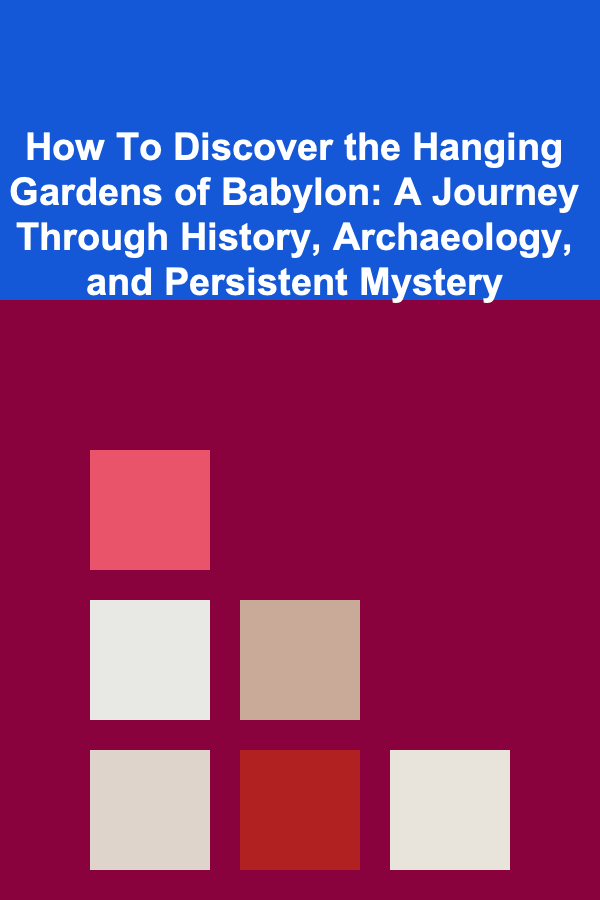
How To Discover the Hanging Gardens of Babylon: A Journey Through History, Archaeology, and Persistent Mystery
ebook include PDF & Audio bundle (Micro Guide)
$12.99$5.99
Limited Time Offer! Order within the next:

The Hanging Gardens of Babylon. The very name conjures images of verdant terraces cascading under the Mesopotamian sun, a testament to engineering prowess and royal love. Listed as one of the Seven Wonders of the Ancient World, these fabled gardens have captivated imaginations for millennia. Yet, unlike other wonders, such as the Great Pyramid of Giza, concrete archaeological evidence of the Hanging Gardens remains elusive. This absence has fueled debate, prompting questions about their very existence, their true location, and the identity of their creator. Discovering the Hanging Gardens, therefore, isn't just about uncovering physical remains; it's a complex and multifaceted journey that requires delving into ancient texts, examining archaeological possibilities, and considering alternative interpretations of historical narratives.
The Challenge of Verification: Absence of Babylonian Sources
The most significant hurdle in the quest to discover the Hanging Gardens is the conspicuous absence of any direct mention of them in surviving Babylonian texts. Inscriptions, cuneiform tablets, and other historical documents from the Babylonian era, which detail various aspects of the city's infrastructure, royal decrees, and everyday life, are silent on the subject of these magnificent gardens. This silence is particularly jarring given the scale and grandeur attributed to the Hanging Gardens by later Greek and Roman writers. Consider the meticulous records kept by Babylonian scribes regarding the construction of ziggurats, temples, and canals. The lack of any similar documentation for the Hanging Gardens raises serious questions about whether they existed in Babylon at all, at least in the form described in classical accounts.
This lack of primary source material throws the reliability of secondary sources into sharp relief. The accounts we rely on come from Greek historians writing centuries after the alleged construction of the Gardens. These accounts, while descriptive and compelling, could be embellished, based on hearsay, or even conflated with other gardens in the region. Therefore, a critical approach to these sources is paramount. We must acknowledge their potential biases, limitations, and the possibility of misinterpretations or inaccuracies passed down through generations.
Examining the Classical Accounts: Seeds of Doubt and Potential Clues
Our primary sources regarding the Hanging Gardens are the writings of Greek and Roman historians such as Diodorus Siculus, Quintus Curtius Rufus, and Strabo. Let's dissect their accounts to understand their strengths, weaknesses, and potential clues hidden within their descriptions.
- Diodorus Siculus: Diodorus, writing in the 1st century BCE, provides one of the most detailed descriptions of the Gardens. He attributes their construction to King Cyrus of Persia (although this is now widely discredited, as Cyrus lived before the supposed timeframe of their creation) and describes the gardens as being square in shape, with each side measuring approximately 400 feet. He emphasizes the sophisticated irrigation system, which involved screws drawing water from the Euphrates River to the upper levels. Diodorus highlights the use of baked brick and asphalt in the construction, as well as thick lead sheets to prevent water from seeping into the foundations.
- Quintus Curtius Rufus: Curtius, writing in the 1st century CE, focuses on the impressive height of the Gardens and their resemblance to a natural mountain range. He also mentions the presence of numerous trees and plants, creating a verdant oasis in the arid landscape. Curtius adds a romantic narrative, attributing the construction of the Gardens to a king (often identified as Nebuchadnezzar II) who built them to please his homesick Median wife, Amytis.
- Strabo: Strabo, writing around the same time as Diodorus, offers a more concise description. He emphasizes the Gardens' vaulted structure and the method of raising water from the Euphrates. He also notes the thickness of the walls, which were said to be 22 feet thick.
While these accounts paint a vivid picture, they also present inconsistencies and raise critical questions. For instance, the attribution to Cyrus by Diodorus is historically inaccurate. Furthermore, the exact dimensions and construction techniques described vary between authors. The romantic narrative involving Nebuchadnezzar and Amytis, while appealing, lacks any corroboration from Babylonian sources. The reliance on hearsay and the potential for embellishment make it difficult to accept these accounts as definitive proof of the Gardens' existence in Babylon.
Despite these challenges, the classical accounts offer valuable clues. They consistently emphasize the following features:
- Elevated Structure: The Gardens were not ground-level but built on a raised platform, creating a tiered effect.
- Sophisticated Irrigation: A complex system was used to lift water from the Euphrates River to the upper levels, ensuring the gardens remained lush and green.
- Engineering Prowess: The construction involved advanced techniques in bricklaying, waterproofing, and structural design.
- Strategic Location: The Gardens were situated near the Euphrates River, providing a readily available water source.
These recurring features can serve as a guide for archaeological investigations, focusing efforts on areas that exhibit evidence of elevated structures, sophisticated irrigation systems, and advanced engineering techniques near the Euphrates River in and around the ancient city of Babylon.
Archaeological Investigations in Babylon: A Century of Searching
The ancient city of Babylon, located in present-day Iraq, has been the subject of extensive archaeological excavations since the late 19th century. German archaeologist Robert Koldewey led the most significant excavations from 1899 to 1917, uncovering the Ishtar Gate, the Processional Way, and the foundations of several palaces and temples. While Koldewey's team unearthed remarkable artifacts and architectural remains, they did not find definitive proof of the Hanging Gardens. However, Koldewey did propose a possible location based on his findings.
Koldewey suggested that a vaulted structure located in the northeast corner of the Southern Palace could be the foundation of the Hanging Gardens. These vaults were constructed with thick walls and a sophisticated drainage system, features that aligned with the descriptions in classical accounts. Koldewey argued that these vaults could have supported the elevated terraces and the extensive planting required for the Gardens.
However, Koldewey's interpretation has been challenged by other scholars. Critics point out that the vaulted structure is located relatively far from the Euphrates River, making the task of raising water to the upper levels more difficult. Furthermore, the vaults lack any evidence of the extensive waterproofing that would have been necessary to prevent water damage to the palace structures below. The lack of any associated botanical remains also casts doubt on Koldewey's theory.
Despite the ongoing debate, Koldewey's work remains invaluable. His meticulous documentation of the archaeological remains in Babylon provides a foundation for future investigations. Modern archaeological techniques, such as ground-penetrating radar and satellite imagery analysis, could potentially reveal new evidence that supports or refutes Koldewey's hypothesis.
Subsequent excavations in Babylon, carried out by Iraqi archaeologists and international teams, have yielded further insights into the city's history and architecture. However, none of these excavations have provided conclusive evidence of the Hanging Gardens. The search continues, driven by the desire to solve one of the ancient world's most enduring mysteries.
A Shift in Perspective: Alternative Locations and the Assyrian Hypothesis
Given the lack of definitive evidence in Babylon, some scholars have proposed alternative locations for the Hanging Gardens. One compelling theory suggests that the Gardens were not located in Babylon at all, but in the Assyrian city of Nineveh, located over 300 miles to the north. This theory, championed by British Assyriologist Stephanie Dalley, challenges the traditional narrative and offers a fresh perspective on the mystery.
Dalley argues that the classical accounts of the Hanging Gardens may have mistakenly attributed them to Babylon due to the fame and prestige of the Babylonian Empire. She points out that the Assyrian king Sennacherib, who ruled from 704 to 681 BCE, constructed extensive gardens and irrigation systems in Nineveh, which were well-documented in Assyrian inscriptions. These inscriptions describe the construction of canals, aqueducts, and terraced gardens that closely resemble the descriptions of the Hanging Gardens in classical accounts.
Furthermore, Dalley suggests that the name "Babylon" may have been used loosely by Greek writers to refer to the entire Mesopotamian region, rather than specifically to the city of Babylon. This could explain why the Gardens were associated with Babylon, even if they were actually located in Nineveh.
The evidence supporting the Assyrian hypothesis includes:
- Assyrian Inscriptions: Sennacherib's inscriptions describe the construction of extensive gardens and irrigation systems in Nineveh, providing concrete evidence of such projects.
- Archaeological Evidence: Archaeological excavations in Nineveh have uncovered remnants of canals, aqueducts, and terraced structures, supporting the existence of large-scale gardens.
- Geographical Considerations: Nineveh's location near the mountains provided a more favorable environment for gardens than the flat plains of Babylon.
- Chronological Alignment: Sennacherib's reign coincides more closely with the timeframe of the Hanging Gardens than the reign of Nebuchadnezzar II.
While the Assyrian hypothesis remains controversial, it offers a plausible explanation for the lack of evidence in Babylon. It challenges the traditional narrative and encourages a broader perspective on the search for the Hanging Gardens. Further archaeological investigations in Nineveh are needed to fully evaluate this theory.
The Role of Environmental Factors and the Ravages of Time
Even if the Hanging Gardens did exist in Babylon or Nineveh, the ravages of time and environmental factors would have significantly impacted their remains. The Mesopotamian region has experienced centuries of erosion, flooding, and human activity, which could have destroyed or obscured the evidence of the Gardens. The construction materials used, such as mud brick and wood, are particularly vulnerable to decay.
The Tigris and Euphrates rivers have also played a role in altering the landscape. Over time, the rivers have shifted their courses, eroding old settlements and burying others under layers of silt. This could explain why the remains of the Hanging Gardens have not been found, even if they were once located near the Euphrates River.
Furthermore, the looting and destruction of archaeological sites in Iraq over the past century have undoubtedly impacted the search for the Hanging Gardens. Illegal excavations and the sale of artifacts on the black market have robbed archaeologists of valuable clues and potentially destroyed important evidence.
Therefore, the absence of evidence does not necessarily equate to the absence of the Hanging Gardens. The environmental and historical factors that have shaped the Mesopotamian landscape must be taken into account when evaluating the archaeological record.
Modern Technologies and Future Directions for Discovery
Despite the challenges, the quest to discover the Hanging Gardens is not over. Modern technologies offer new tools and techniques for archaeological investigation, potentially leading to a breakthrough in the future. Some promising avenues of research include:
- Ground-Penetrating Radar (GPR): GPR can be used to detect subsurface structures and anomalies without the need for excavation. This technology could potentially reveal the foundations of the Hanging Gardens, even if they are buried beneath layers of soil and debris.
- Satellite Imagery Analysis: High-resolution satellite imagery can be used to identify subtle changes in the landscape that might indicate the presence of buried structures. This technology can also be used to map ancient irrigation systems and canals, providing clues about the location of the Hanging Gardens.
- LiDAR (Light Detection and Ranging): LiDAR uses laser technology to create detailed 3D models of the landscape, revealing subtle variations in elevation that might be missed by traditional surveying methods. This technology can be particularly useful in identifying terraced structures and other features associated with the Hanging Gardens.
- Botanical Analysis: Analyzing soil samples from potential garden sites could reveal the types of plants that were grown in the Hanging Gardens. This information could help to confirm the existence of the Gardens and provide insights into their design and function.
- Virtual Reality Reconstruction: Using existing textual and archaeological data, virtual reality simulations can be created to visualize the Hanging Gardens in their original form. This can aid in understanding their layout, construction, and operation, and can help to identify potential areas for further investigation.
Furthermore, international collaboration and the sharing of knowledge and resources are essential for advancing the search for the Hanging Gardens. Archaeologists, historians, engineers, and other experts from around the world must work together to solve this enduring mystery.
Conclusion: The Enduring Allure of the Unknown
The search for the Hanging Gardens of Babylon remains a fascinating and challenging endeavor. The lack of definitive evidence in Babylon has led to alternative theories, such as the Assyrian hypothesis, and has highlighted the limitations of our current knowledge. The ravages of time, environmental factors, and human activity have all contributed to the difficulty of finding concrete evidence of the Gardens.
However, the absence of proof does not negate the possibility of their existence. The classical accounts, while potentially embellished, provide valuable clues about the Gardens' design and function. Modern technologies offer new tools for archaeological investigation, and international collaboration can help to advance the search.
Ultimately, the mystery of the Hanging Gardens of Babylon is a testament to the enduring power of myth and the allure of the unknown. Whether they existed in Babylon, Nineveh, or somewhere else entirely, the Hanging Gardens continue to inspire awe and wonder. The quest to discover them is a journey through history, archaeology, and the boundless realm of human imagination, a journey that may one day lead to the unearthing of one of the ancient world's most cherished treasures.

How to Add Color to Your Home Without Spending a Fortune
Read More
How to Create a Pollinator-friendly Garden Layout
Read More
How to Evaluate the Effectiveness of Your Soundproofing Efforts
Read More
How to Troubleshoot Common Dishwasher Problems
Read More
How to Analyze Water Quality for Contaminants
Read More
10 Tips for Customizing Printable Masks with Paint and Embellishments
Read MoreOther Products

How to Add Color to Your Home Without Spending a Fortune
Read More
How to Create a Pollinator-friendly Garden Layout
Read More
How to Evaluate the Effectiveness of Your Soundproofing Efforts
Read More
How to Troubleshoot Common Dishwasher Problems
Read More
How to Analyze Water Quality for Contaminants
Read More